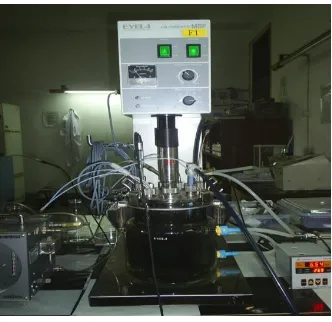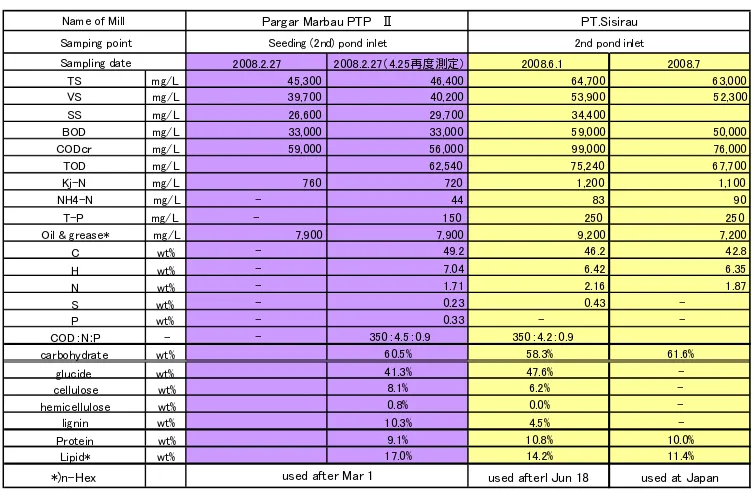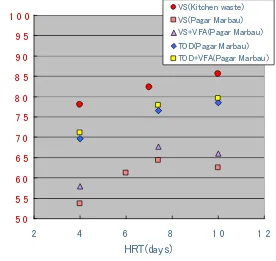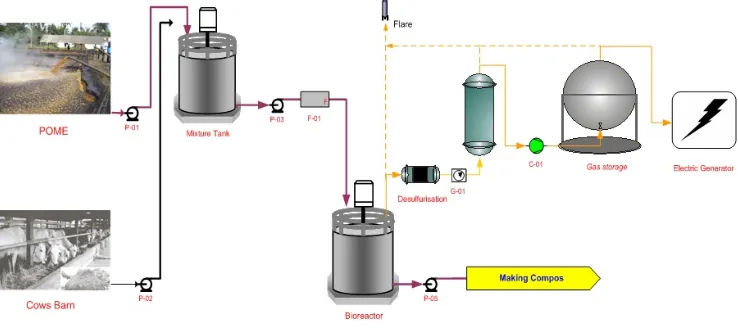All sources 22 Internet sources 22
1 documents with identical matches [11] https://patents.google.com/patent/EP0461166A1/en
1 documents with identical matches
9.0%
Results of plagiarism analysis from 2017-12-07 21:23 UTC26. Full Paper to Intl Conference.doc
Date: 2017-12-07 21:19 UTC
9 pages, 2214 words
PlagLevel: selected / overall
Settings
Data policy: Compare with web sources
Sensitivity: High
Bibliography: Bibliography excluded
Citation detection: No detection
--Design of Biogas Electricity Generator Pilot Plant by Cow-Palm
[0]
Plantation Integration
Irvan *), Bambang Trisakti *), Fahmi *), Yusuf Husni **), and Nevi Diana Hanafi **) *) Engineering Faculty, University of Sumatera Utara Medan , 20155, Indonesia
**) Agriculture Faculty, University of Sumatera Utara, Medan 20155, Indonesia
ABSTRACT
Wastewater treatment utility is one of the most important components in the palm oil
production. This utility is normally [2] used to treat a large volume of palm oil mill effluent (POME) generated during the production of crude palm oil (CPO) before the effluent is safely discharged to the surrounding environment through water ditch or river. [0]The production of POME in Indonesia is estimated around 28.7 million tonnes per year.[7] Most of the palm oil mills use conventional pond system to treat their POME. However this system has many disadvantages such as:[2] long retention time (90-120 days), large area required, high demand for maintenance, loss of nutrition and high emission of methane.[0]
Previous research in the laboratory scale have produced large volume of biogas and high decomposition rate of COD, however prior to be filled to the fermentor tank POME should be added by ammonium bicarbonate as nitrogen source. [0]In order to be applied to the industry, this method should find the alternative nitrogen source which has criteria such as; cheap, easy to obtain, and available in any time (continuity).[2] One of the nitrogen sources which fulfill this criteria is cow manure or dung.
The objective of the project is to design a more efficient POME treatment plant [1]
using an anaerobic continous stirred tank reactor (CSTR) in the pilot plant scale. The [2] produced methane gas will be used to generate electricity with capacity of 15-20 kWh. For natural nitrogen source cow manure will be used, and in order to obtain them easily [0]
and cheaply, cow-palm plantation integration concept will be adopted.
Biogas electricity generator pilot plant will be operated by making variation of hydrolic retention time (HRT), namely HRT 10, 8, 6 and 4 days.[0]Quality and quantity of produced biogas will be recorded daily on each HRT, produced electricity will be recorded as well.
INTRODUCTION
World consumption for palm oil in 2003-2007 was around 117.88 million tonnes.
Indonesia as the second largest palm oil producer can only supply around 6 million [2]
tonnes CPO while Malaysia can supply more or less 8-9 million tonnes of CPO. High [1]
production of POME concomitantly is followed by the high production of the mill waste,
either of waste water so-called palm oil mill effluent (POME) or solid waste such as
empty fruits bunch (EFB), shell, fibre etc. POME production is estimated about 28.[1]7
million tonnes/year and production of solid waste is about 15.2 million tonnes/year. This
high production of POME is surely the potential source to produce bigas.[0](Igwe, 2007)
Researchs to produce biogas from POME have been explored by many
1996). Based on the previous experiment using POME from palm oil mill Pagar Merbau
PTPN II, the ratio of COD: N: P was 350:4:1. This means POME from Pagar Merbau is
lack of nitrogen, therefore the decomposition rate is relatively low.
Nitrogen content in POME usually was enlarged by adding with other nitrogen
source such as urea. However, since the amount of POME is very big, of course, urea
needed in the big amount as well. As we know, the need of urea as fertilizer increases
everyday. Alternatively, nitrogen content in POME can be increased by adding the
POME with other waste which contains rich nitrogen sources. One of the wastes is cow
manure.
Cow-palm plantation integration which raising cows in the palm plantation area is
the ideal solution. The rich nitrogen content in cow manure will be available in the big
amount and the continuity is guaranteed. This integration system will also increase the
production of cow meat in big amount.
Agriculture Department of Republic Indonesia has introduced the cow-palm oil
plantation program. This program has succeeded in many plantations. Therefore
Agriculture Department prepared budget of 150 billion rupiah for buying cows to be
especially big plantation consider cows as plant disease. When the cows enter the
plantation area which surrounded by young palm trees, then the leaves of the young trees
will be ate by the cows, of course the growth of the young trees will be disturbed. This
problem can be solved by applying intensive or semi intensive methods. Intensive
method more expensive because the entire foodstuff should be available, but the cow
manure whether the solid or the liquid manure can be collected. Other method is semi
intensive method where the cows are released in the palm plantation, but their wastes
especially the liquid will scatter on the area.(Batubara, 1999)
This research will study the improvement of biogas production using combination
of POME and cow manure. Then, the gas production will be used as fuel to generate
electricity of 15 20 kWh. In order to achieve this target, this system will be designed – in
the pilot plant scale.
ANAEROBIC TREATMENT OF POME
The research of biogas production from anaerobic tank fermentor of POME has
been performed for two years. Experiments are conducted in laboratory scale and pilot
plant scale (on going).
A. Laboratory scale of anaerobic treatment of POME
It was started in 2008 when Lembaga Penelitian dan Pengabdian Pada Masyarakat
(LP3M) USU collaborated with Metawater Co. Ltd, one of Japanese big companies to
perform joint research to study the fermentation of POME to biogas. The purpose of this
joint research is to obtain the baseline data needed by palm oil companies in order to
apply clean development mechanism (CDM) project for their plant. Therefore besides to
reduce gas house gasses (GHG) emission, the plant can produce biogas as fuel to
generate electricity.
The experiment was conducted in Ecology Laboratory, Chemical Engineering [3]
Department USU. Besides lending their equipments Metawater Co., Ltd-Japan also sends
their experts to USU.[5] The fermentation process took place in a 2-litres-capacity
transparent jar digester (EYELA, Model MBF 300ME) which is provided with
turbine agitator as well as alarm indicator bulb anticipating temperature disorder. A data [5]
logger (KEYENCE, Model NR-250) is connected to computer to enable automatic
recording of temperature and pH provided by sensoring equipments attached to digester.
The experimental equipment for the 2-L digester is shown in Figure 1. [3]
Figure 1. Two litters fermentor used in this research
As the raw material for the experimental anaerobic digestion observed, a real POME
obtained from Pagar Merbau Mill of PTPN II and PT.[3] Sisirau Mill waste water treatment
facilities were used. Table 1 summarizes the main physical and chemical properties of [18]
this material, while biogas production is shown in Table 2.
From Table 1, it can be seen that ratio of COD, N and P is not similar to ideal [9]
ratio recommended by some literature that is 350:7:1. It is clearly seen that both POME is
still lack of nitrogen, therefore in this experiment ammonium bicarbonate was added as
Tabel 1. Properties of POME from Pagar Merbau and PT.Sisirau
Tabel 2. Experimental results of laboratory scale
POME PKS PT. Sisirau PKS Pagar Merbau
HRT (days) 8 10 20 4 6 8 10
2008.2.27 2008.2.27(4.25再度測定) 2008.6.1 2008.7
TS mg/L 45,300 46,400 64,700 63,000
VS mg/L 39,700 40,200 53,900 52,300
SS mg/L 26,600 29,700 34,400
BOD mg/L 33,000 33,000 59,000 50,000
CODcr mg/L 59,000 56,000 99,000 76,000
TOD mg/L 62,540 75,240 67,700
Kj-N mg/L 760 720 1,200 1,100
NH4-N mg/L - 44 83 90
T-P mg/L - 150 250 250
Oil & grease* mg/L 7,900 7,900 9,200 7,200
C wt% - 49.2 46.2 42.8
*)n-Hex used afterl Jun 18 used at Japan Name of Mill
Sampling date Samping point
Pargar Marbau PTP Ⅱ
used after Mar 1
Seeding (2nd) pond inlet 2nd pond inlet
From table 2 shows that although biogas production from both POME are relatively high,
Figure 2. Relationship between HRT and decomposition rate
B. Pilot plant of anaerobic treatment of POME
Another anaerobic treatment of POME will be performed using a pilot plant
equipped with a fermentor type continuous stirred tank reactor (CSTR). The CSTR type
was chosen, because this type of fermentor has relatively low energy consumption, less
risk in operation and an easy start up. Furthermore a high performance could be expected.
The following aspects are considered: [0]
a. performance (max. loading rate, efficiency, min.[1] hydraulic retention time)
b. risk of plugging
The pilot plant was located at Pusdiklat LP3M USU Jl. Dr. Mansyur. Figure 3 shows the
flowsheet of the pilot plant. The pilot consists of main equipment such as: the mixture
tank, biogas fermentor, gas storage, compressor, biogas generator set.
Figure 3. Flowsheet of pilot plant in this research
The technical data of the pilot plant components:
1. Mixture Tank:
Volume : 1000 L
Motor : 1400 rpm
Power : 1 Hp
Gear Box : ratio 1: 60
Accesories: Baffle, level controller, main hole, sampling hole
2. Pump:
Type : Centrifugal
Power : 1 Hp
Accessories: ball valve, check valve
3. Fermentor Tank:
Volume : 3000 L
Motor : 1400 rpm
Gear Box : ratio 1: 60
Heater : 3 kW
Accessories: main hole, sampling hole, insulator,
4. Biogas Tank:
Volume : 2000 L
Accessories : man hole, water trap.
5. Compressor:
Type: Reciprocating
Power : 1 Hp
6. Generator set
Machine: ex engine of Daihatsu car
Cylinder: 1600 cc
Combustion: Carburetor
Dynamo: 12 kVa
7. Others: Control Panel, Controller, wet gas meter, analysis equipments
The fresh POME and cow manure are filled into the mixture tank, where the POME
is maintained to pH 7 using the manure. The pump sucks the mixture wastes from the
mixture tank and fed into the upper of the fermentor tank. Nearly all equipments involved
were electricity driven. Feeding and temperature recordings were done automatically, as
well as mixing and operations of reactor. The mode of the fermentor operation is
intermitten, where POME from mixture tank is flown into the fermentor four times
maintained by using timer. The fermentor occurs at thermophilic condition of 55 oC. The
liquid inside the fermentor are analyzed periodically.[1] Variables checked and analyzed
here consisted of volume of biogas produced, pH, M-alkalinity, total solid, volatile solid
and rough measurement of CO2 and H2S concentration. Other examinations such as
CODcr, T-N, elemental composition analysis (C,H,N,S) and gas composition (CH4, CO2,
H2S) were completed at the external laboratory.
Produced gases are then flown into the water trap to collect the unexpected water in
the bogas. The flow of the produced biogas is measured by using gas meter. Biogas are
Acknowledgements
This research was developed thanks to a research grant from Hibah Kompetitif
Penelitian Unggulan Strategis Nasional No: 429/SP2H/PP/DP2M/VI/2009 date 25 June
2009, and also special thanks to Prof. Darwin Dalimunthe for his supervision
References
Speece, R.E. 1996. Anaerobic Biotechnology for Industrial Wastewaters. USA: Archae
Press.
APHA. 1992. Standard Methods for the Examination of Water and waste water. 18th ed.
New York. American Public Health Association.
Batubara, A., I. Kasup, A.A. Kesma. A. Irfan, H. Simanjuntak dan Harahap. 1999. Kajian
integrasi penggemukan ternak sapi potong di lahan perkebunan kelapa sawit.
Laporan Hasil Kegiatan BPTP Riau. 2000
Dinas Pertanian, Direktorat Jenderal Perkebunan, 2006. Statistik Perkebunan Indonesia,
Kelapa Sawit (Oil Palma).
Igwe JC dan Onyegbado CC. 2007. A review of Palm Oil Mill Effluent (POME) Water
Treatment. Global Journal of Environmental Research 1 (2): 54-62.
Metcalf dan Eddy. 1991. Wastewater Engineering: Treatment Disposal Reuse.



